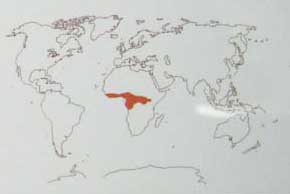
Smutsia gigantea (*)
Superregnum: Eukaryota
Regnum: Animalia
Subregnum: Eumetazoa
Cladus: Bilateria
Cladus: Nephrozoa
Superphylum: Deuterostomia
Phylum: Chordata
Cladus: Craniata
Subphylum: Vertebrata
Infraphylum: Gnathostomata
Superclassis: Tetrapoda
Cladus: Reptiliomorpha
Cladus: Amniota
Cladus: Synapsida
Cladus: Eupelycosauria
Cladus: Sphenacodontia
Cladus: Sphenacodontoidea
Ordo: Therapsida
Cladus: Theriodontia
Subordo: Cynodontia
Cladus: Mammaliaformes
Classis: Mammalia
Subclassis: Trechnotheria
Infraclassis: Zatheria
Supercohort: Theria
Cohort: Eutheria
Cohort: Placentalia
Cladus: Boreoeutheria
Superordo: Laurasiatheria
Cladus: Ferae
Ordo: Pholidota
Familia: Manidae
Genus: Smutsia
Species: Smutsia gigantea
Name
Smutsia gigantea (Illiger, 1815)
Type locality: Not indicated.
Synonyms
Manis gigantea Illiger, 1815
Manis wagneri Fitzinger, 1872
Pholidotus africanus (Gray, 1865)

Smutsia gigantea, Photo: Michael Lahanas
References
Abh. Phys. Klasse K. Pruess Konigl. Akad. Wiss.: 84.
Smutsia gigantea in Mammal Species of the World.
Wilson, Don E. & Reeder, DeeAnn M. (Editors) 2005. Mammal Species of the World – A Taxonomic and Geographic Reference. Third edition. ISBN 0-8018-8221-4.
IUCN: Smutsia gigantea (Illiger, 1815) (Near Threatened)
Smutsia gigantea Illiger, 1815 – Taxon details on Integrated Taxonomic Information System (ITIS).
Vernacular names
English: Giant Ground Pangolin, Giant Pangolin
magyar: Óriás tobzoska
polski: Łuskowiec olbrzymi
The giant pangolin (Smutsia gigantea) is the largest species in the family of pangolins or scaly anteaters.[2][3] Members of the species inhabit Africa with a range stretching along the equator from West Africa to Uganda. It subsists almost entirely on ants and termites. The species was first described by Johann Karl Wilhelm Illiger in 1815.
Description
The giant pangolin is the largest of all pangolin species. While its average mass has not been measured, one specimen was found to weigh 33 kg (72.6 lb). Males are larger than females, with male body lengths about 140 cm (4.6 ft) and females about 125 cm (4.1 ft). Like all pangolins, the species is armored with large, brown to reddish-brown scales formed from keratin. Curiously, it also has eyelashes. The giant pangolin has a long snout, a long, thick tail, and large front claws.
The animal has a strong sense of smell and large anal glands. Its secretions may be significant to animal communication. The species walks with most of its weight on its columnar rear legs, and curls its front paws, walking on the outside of the wrists rather than the palms to protect the claws. By using its tail for balance, it often walks upright as a biped.
Distribution and habitat
By Joseph Wolf
The giant pangolin inhabits many countries, with the largest concentration in Uganda, Tanzania, and western Kenya. It is found mainly in the savanna, rainforest, and forest, inhabiting areas with large termite populations and available water. It does not inhabit high-altitude areas.
Behavior and ecology
Specimen
The giant pangolin, like other pangolins, is nocturnal, which makes observation difficult. It is also usually solitary, although in one case an adult was seen in a burrow with a juvenile. The species is capable of climbing trees and other objects.
Diet
Like all pangolins, the giant pangolin is a specialized insectivore that lacks teeth and the ability to chew. Its diet mainly consists of ants and termites, which it finds by tearing open anthills and termite nests, both subterranean and mound-type.
Because of its relatively large size, the giant pangolin is particularly well-suited to breaking open termite mounds by leaning on the mound and resting its weight on its tail, and then ripping into the mound with its front claws. The combination of weight and physical damage quickly leads to a partial collapse of the mound, exposing the termites. Only the adults are strong enough to do this; their young must follow behind their mothers until they grow large enough to do it for themselves. It eats the insects by picking them up with its sticky tongue, which is up to 16 in (41 cm) long.
Reproduction
Very little information about the reproduction of the giant pangolin is known. Two birth records exist, with one litter in September and another in October, with the young weighing around 500 g (18 oz). As in all pangolins, infants have soft scales that eventually harden, and are born with open eyes. They cannot walk on their legs, but can move on their bellies. During age 6–8 weeks, the young often spew a yellow secretion from their anal glands(that is often said to smell of decay and cabbage) to keep predators and other animals from taking advantage of their mothers.
Threats
The giant pangolin is threatened by habitat destruction and deforestation, and hunting for the bushmeat trade.[1] Between 2011 and 2015, nine shipments with pangolin body parts were seized in Asia that originated in Nigeria. They contained 3,000 kg (6,600 lb) pangolin meat and close to 5,500 kg (12,100 lb) pangolin scales that were destined to China and Laos.[4]
Conservation
The giant pangolin has been listed on CITES Appendix I since January 2017.[1]
References
Nixon, S.; Pietersen, D.; Challender, D.; Hoffmann, M.; Godwill Ichu, I.; Bruce, T.; Ingram, D.J.; Matthews, N. & Shirley, M.H. (2019). "Smutsia gigantea". IUCN Red List of Threatened Species. 2019: e.T12762A123584478. doi:10.2305/IUCN.UK.2019-3.RLTS.T12762A123584478.en. Retrieved 17 January 2022.
Schlitter, D.A. (2005). "Order Pholidota". In Wilson, D.E.; Reeder, D.M (eds.). Mammal Species of the World: A Taxonomic and Geographic Reference (3rd ed.). Johns Hopkins University Press. p. 530. ISBN 978-0-8018-8221-0. OCLC 62265494.
Gaudin, Timothy (2009). "The Phylogeny of Living and Extinct Pangolins (Mammalia, Pholidota) and Associated Taxa: A Morphology Based Analysis" (PDF). Journal of Mammalian Evolution. 16 (4): 235–305. doi:10.1007/s10914-009-9119-9. S2CID 1773698. Retrieved 14 May 2015.
Gomez, L.; Leupen, B.T.C. & Hwa, T.K. (2016). "The trade of African pangolins to Asia: a brief case study of pangolin shipments from Nigeria" (PDF). Traffic Bulletin. 28 (1).
Retrieved from "http://en.wikipedia.org/"
All text is available under the terms of the GNU Free Documentation License



